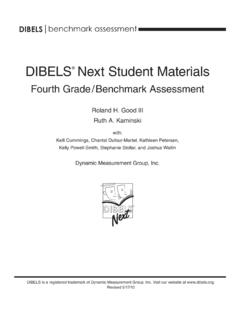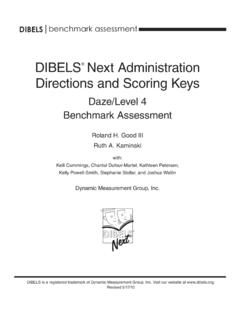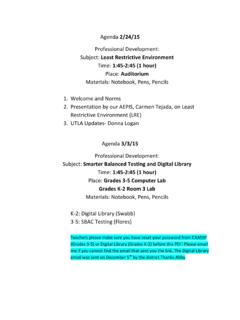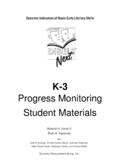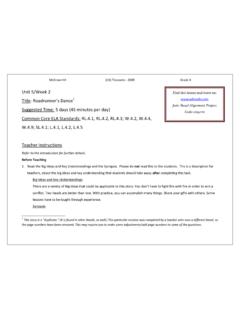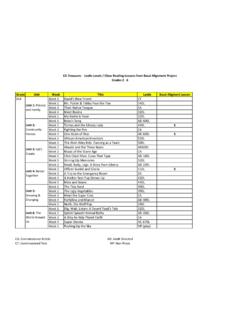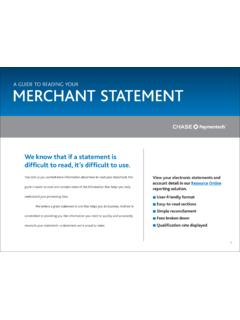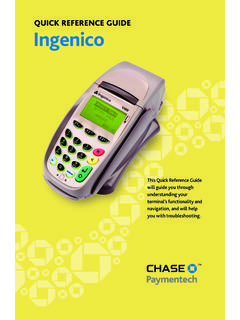Transcription of DIBELS Next Student Materials - Chase Street …
1 DIBELS benchmark assessment DIBELS next Student Materials . Fifth Grade/Benchmark Assessment Roland H. Good III. Ruth A. Kaminski with: Kelli Cummings, Chantal Dufour-Martel, Kathleen Petersen, Kelly Powell-Smith, Stephanie Stollar, and Joshua Wallin Dynamic Measurement Group, Inc.. DIBELS is a registered trademark of Dynamic Measurement Group, Inc. Visit our website at Revised 5/17/10. The Land Bridge During the last ice age, the world looked much different than it does today. Nearly all the land was covered with huge sheets of ice or glaciers. Most of the world's water was trapped in these glaciers, and the water level of the seas was low. A vast amount of land was above the water. The narrow waterway between Asia and North America, the Bering Strait, was mostly exposed land at that time. The land formed a narrow bridge that connected Asia with North America.
2 This land bridge was cold and flat, and was covered by grass and shrubs. Before the formation of the land bridge, early people who wanted to travel to North America had to go by boat. Very few people actually made the voyage over the water. Many more people traveled to North America when they were able to walk across the land bridge. After crossing the land bridge, the earliest people found themselves in an unfamiliar land where there were no other inhabitants. These first people had to search for food and water. If they were to survive, they also had to locate Materials that they could use to fashion tools. There are no written accounts of these early people. Scientists who want to know how they lived must seek clues in the things they left behind. Today, it is believed that the movement to the new world took place over a long period of time.
3 The earliest people most likely came to the new world as they followed migrating animals. After many thousands of years, the climate began to change, causing much of the ice to melt. The land bridge flooded and the Bering Strait became a waterway once again. The two continents became separated and the land bridge was no more. Those who wanted to journey between the continents would have to travel by boat or find a new way to travel. DIBELS Benchmark Assessment Page 1. Oral Reading Fluency G5/Benchmark The Crow and the Pitcher Once there lived a sleek, black crow. Crow's shiny feathers glistened in the sunlight, and his yellow eyes sparkled like precious jewels. Crow was so strong that he frequently flew for hundreds of miles without stopping. One day, Crow was flying along when he started to feel thirsty.
4 He dropped to a low altitude to search for something refreshing to drink. Suddenly, he spied a pitcher of water sitting on a barnyard fence. The fence was in the shade, shielded from the sun by a towering oak tree. That water should make a nice, cool drink, thought Crow. Crow landed on the fence and examined the tempting pitcher. He saw that it was about half full of water. However, no matter how hard he tried, he could not reach the water with his beak. Crow was frustrated, but he wasn't ready to give up. He knew if he considered the situation carefully he would be able to find a solution. Crow considered overturning the pitcher, hoping that the water would spill so he could drink it. He rejected that idea, fearing that all the water would flow away before he could get any. It would be a shame to waste this treat, Crow thought.
5 He looked all around for some more ideas, and saw some shiny pebbles lying on the ground. Looking at them, Crow finally had the inspiration he had been looking for. Crow picked up the pebbles one by one with his beak and dropped them into the pitcher. Every time he dropped a pebble into the pitcher, the water level rose higher. Eventually, the water level was high enough for Crow to take a long, refreshing gulp of water. He was very pleased with himself. No obstacle is too challenging if I think long enough and hard enough about how to resolve it, thought Crow. DIBELS Benchmark Assessment Page 2. Oral Reading Fluency G5/Benchmark Recycling Tires If you look around, you will see tires everywhere. There are tires on automobiles and trucks, and there are tires on motorcycles and airplanes. Eventually, all these tires will be thrown away, creating a huge mountain of tires.
6 You might be surprised to learn that old tires are one of the biggest and most challenging sources of trash. The piles of old tires frequently become home to mosquitoes and other insects that carry disease. Discarded tires are a dangerous fire hazard. The pollution caused by tire fires is very harmful to the environment. Because old tires don't decay, they are a problem that will be around for a long, long time. Those who care about the environment are worried about the large volume of old tires. They are researching ways to recycle and reuse the rubber in tires. That way they can keep old tires out of landfills and protect the environment. One way to recycle the rubber is to heat the tires in a special oven. The oven does not allow any oxygen in and allows few pollutants out. The recycled rubber can then be used for new products like shoes and even sweaters.
7 Recycling the rubber also produces oil that people can use as fuel. Fuel from tires can produce as much energy as coal or oil and is often used to power major factories. Not all tires need to be recycled, many can be reused. Scrap tires can be placed around bridges to protect them from flood damage. Some tires are cut into pieces and fashioned into sandals or used in roads. Shredded tires can be used to make walls that reduce the noise from highways for people who live nearby. Shredded tires can even make railroad ties to reduce our need for trees. I hope you will see tires in a whole new light. The tire on your automobile might eventually be used for the shoes on your feet or the asphalt on the road you walk on to get to school. DIBELS Benchmark Assessment Page 3. Oral Reading Fluency G5/Benchmark A Genius at Work The boy was seven years old and starting school for the first time.
8 He was the only son of a poor family who lived in what is now part of Germany. To look at this child, he seemed like an ordinary boy; however, he had an amazing talent in math and science. In fact, he would go on to become one of the most important mathematicians in the world. The boy's name was Carl Gauss. He reportedly was able to calculate in his head by the time he was three years old. The youngster was so good in math that he corrected mistakes that his father made when computing the family budget. Carl also showed his superior abilities in math at school. One time, his teacher asked the students to add the list of numbers from one to one hundred. The teacher thought that this would take the students a long time. To his surprise, young Carl arrived at the correct answer almost instantly.
9 The boy explained that he had found a clever way to pair the numbers that allowed him to turn the problem into a simple multiplication calculation. He could use this method to add a long string of numbers very quickly. Carl's mother and father had different views about their son's education. His father was a mason who built things with brick and stone. Carl's father wanted Carl to become a mason, too. The boy's mother, though, strongly supported Carl's schooling in math and science because she realized that he had a special talent in these areas. Carl continued his studies in math and science and went on to make many important discoveries. Some of his first discoveries were made while he was still a teenager. Carl Gauss became known throughout the world as the Prince of Mathematicians. Although he lived long ago, his keen understanding of math continues to have a remarkable influence on the field of math today.
10 DIBELS Benchmark Assessment Page 4. Oral Reading Fluency G5/Benchmark A Special Song The boy searched through the pieces of bamboo that his mother had cut. He ran his hands over numerous pieces to know what each would feel like when he held it. He narrowed down his choice to three pieces. He looked down the hollow centers of those pieces. Finally, he picked the one that he thought would make the best flute. As Zachary presented the piece of bamboo to his mother, she admired his selection. She proceeded to turn the bamboo into a flute with six perfect holes in a straight line and a hole for the mouth. She provided some special oil, which her son gently applied to his fabulous new instrument. Zachary anticipated making lovely melodies with his flute. He pressed the instrument firmly against his lips and blew into it with a deep breath.
